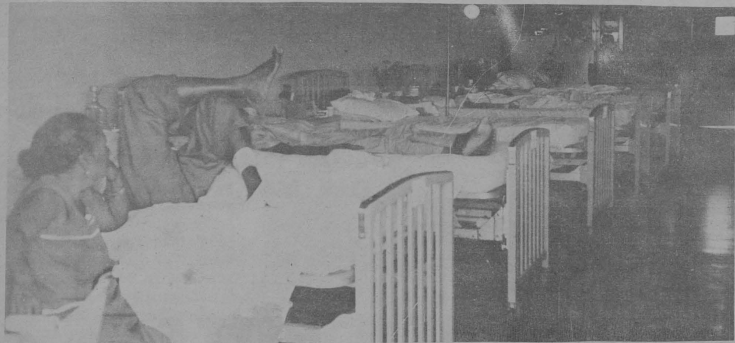
At the Dr. Torres Memorial Hospital, Nov. 1973.
THE Doctor Torres Memorial Hospital was named after Jose Diaz Torres, who trained in medicine at a small hospital on Saipan during the German era (1899-1914), and later “received one year of formal medical schooling in Japan,” which took over the Northern Marianas in 1914. He became known as the island’s first local doctor.
In 1960, a detachment of Seabees began the construction of a hospital in what is now the site of Northern Marianas College on As Terlaje Hill. In 1961, a Guam firm was awarded the contract for the construction of hospital buildings. A year later, the U.S. Navy turned over the brand new hospital to the U.S.-administered Trust Territory government. (Sources: U.S. Congressional Record and the Micronesian Reporter.)
In November 1973, Marianas Variety featured the hospital in a banner story titled: “Saipan’s Hospital: Referrals or Improvement.”
“An average of 15 patients are sent to Guam or Hawaiian hospitals from the Marianas each month,” MV reported. “The cost of these patients runs about $126/day [worth about $880 today] for hospitalization…. This cost does not include charges for transportation for the patient, an accompanying family member, per diem, special nursing care, etc.”
According to MV, “The average hospitalization or stay in Guam or Honolulu is two weeks, depending on whether it is for diagnostic procedures or surgery, the two main reasons for sending patients out of the [Marianas] district.”
A hospital official told Variety that the “money for treatment and other charges does not come from the annual $60,000 budget [worth about $419,000 today] for the…hospital. The total cost to the Marianas for referrals during FY 73 was $48,496 [worth about $330,000 today]. This was to treat 89 clinical patients (not requiring hospitalization) and critical cases requiring urgent attention in the Guam Naval Hospital alone. The costs of sending patients to Honolulu, of course, will be considerably higher with the increased transportation costs.”
Variety learned that Saipan’s hospital “is too small and poorly designed to meet the needs” of the Northern Marianas population, which was about 14,000 in 1973. For example, “the restrooms are too few and poorly located for the over 150 outpatients visiting daily. The patients are served by 6 medical officers, one of whom is actually in training overseas and is assigned to Rota. There is one U.S. physician and one Filipino. One doctor is on night duty every night and 5 are assigned regular hours during the day.”
Without additional funding for the hospital, “there was little hope for an increase to expand or improve the facilities in the near future.” Doctors were overworked, “but it was noted that this is a common problem with the profession anywhere.” Still, “there were not enough doctors.” The head of the hospital “must wear two hats, administrator and doctor, sometimes working 32 hours straight. He admits to lower efficiency….”
As for the hospital’s staffing needs, it “is hard to pin down” because “personnel are always either circulating between advanced training, needed vacations and high turnover in expatriate MDs….”
However, new hospital facilities were needed, and these included “improved storage facilities, and air-conditioning of the surgical ward.”
A hospital official said “there is never real satisfaction in a medical system subsidized by the government. They must operate within a budget set by others and it was [the hospital’s] duty to figure how to do it.”
And then the hospital official said something that no patient would like to hear: “This hospital is very dangerous. It could be cheaper to build a new one than to renovate this.”
This was state of the island’s only hospital under U.S. administration.
The big question, according to the MV report, “is whether or not the 50,-60,000 dollars…being spent outside on medical referrals…could not be better invested in improving the present health delivery system or in the construction of modern adequate facilities which would avoid the need to send so many patients at such a great cost to the other hospitals.”
Since then, how many times have we heard an official or politician say the same thing? But it should also be pointed out, that the island’s public hospital, now known as CHCC, has improved tremendously since 1973. In terms of modern amenities and convenience, moreover, the NMI as a whole has vastly improved. The key was the growth of the local economy.
“I had to stop the medical referral program [in 1995] because we didn’t have the money,” then-Gov. Froilan C. Tenorio said in an interview in 1997. “Now we have it,” he added. “This is the thing. I just have to tell the people look, if you want me to provide you the services that you expect from the government, then you’d better favor economic development.”
Today, however, the NMI is like a Trust Territory district again, but this time with all its officials locally elected. The local economy is contracting and the NMI can do little about it because of the punitive and expensive mandates imposed by faraway federal officials.
Still, in the TT days, most local residents were, more or less, “stuck” in the Northern Marianas. Today, thanks to the Covenant that their representatives negotiated with the U.S., local residents are U.S. citizens who can up and leave, and head to the states or the other territories.
Send feedback to editor@mvariety.com











